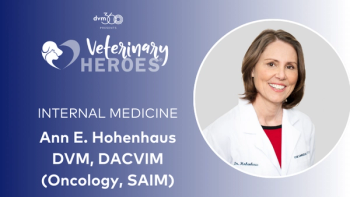
Communication cornerstone to therapeutic success
Reduction in appetite indicates that the induction phase of therapy has been completed.
Q. Please review preferred treatment for pituitary-dependent hyperadrenocorticism in dogs.
A. Dr. Edward C. Feldman at the 2005 American College of Veterinary Internal Medical Forum in Baltimore gave a lecture on treatment of hyperadrenocorticism in dogs. Some relevant points in this lecture are provided below.
The preferred medical therapy for pituitary-dependent hyperadrenocorticism in dogs is either lysodren or trilostane therapy.
Induction protocol for Lysodren
Lysodren (o,p'-DDD) therapy is initiated at home with the owner administering 25 mg/kg, given twice daily. Glucocorticoids are not routinely administered and are not routinely dispensed. Rather, the owner should receive thorough instructions on the actions of o,p'-DDD. Then, the owner is instructed to begin reducing their dog's food allotment by one-third beginning the day before o,p'-DDD is begun. Therapy is often started on Sundays. In other words, owners give their dog one-third of its normal food allotment each morning and again each afternoon, beginning on a Saturday. This should make the typical polyphagic dog ravenous. No dog with a poor appetite should ever receive this drug! Lysodren administration should be stopped when
1) The polydipsic dog's daily water consumption approaches 60 ml/kg.
2) The dog simply takes longer to consume a meal and certainly if it develops partial or complete inappetence.
3) vomiting,
4) diarrhea,
5) unusual listlessness.
Any of these signs is an indication for the owner to stop daily o,p'-DDD therapy and have the dog examined by the veterinarian. The single most reliable and consistent indicator for stopping the induction phase of therapy is appetite. Any reduction in appetite indicates that the induction phase of therapy has been completed. The water intake in polydipsic dogs may decrease in as few as two days or in as long as 35 days (average is five to 14 days).
Lysodren is quite successful in eliminating signs of hyperadrenocorticism. This should be coupled with close communication between owner and veterinarian. Either the veterinarian or a technician should call the owner every day beginning with the second day of therapy. The owner should be impressed with the veterinarian's concern and will observe the animal closely. The owners are instructed to feed their dogs two small meals each day. The dog's appetite should be observed prior to each o,p'-DDD administration. If food is rapidly consumed, medication can be given. If food is consumed slowly, incompletely or not at all, the medication should not be given until the veterinarian is notified and an ACTH-response test is performed. In addition to making daily phone calls, the veterinarian should see the dog eight to nine days after beginning therapy. At this time, a thorough history, physical examination and an ACTH-response test should be performed. Dogs that have responded clinically to the medication (or if the owner is not certain about response) should have further therapy withheld until results of the ACTH-response test can be evaluated.
The goals of therapy with o,p'-DDD are to achieve resolution of the clinical signs and an ACTH-response test that is suggestive of relative hypoadrenocorticism. Successful response to o,p'-DDD is indicated by pre- and post-ACTH plasma cortisol concentrations greater than 1.5 micrograms per dl and less than 5 micrograms per dl.
Maintenance therapy for lysodren
The maintenance phase of therapy with o,p'-DDD may be initiated once a hypoadrenal response to ACTH is obtained. If the dog with hyperadrenocorticism has a normal or exaggerated response to ACTH following the initial eight to nine days of o,p'-DDD therapy, daily medication should be continued. While quite unusual, it is continued for three to seven additional days. ACTH response tests should be repeated every seven to 10 days until a low post-ACTH plasma cortisol concentration is achieved. It is important to emphasize that each dog should be treated as an individual. There appears to be no reliable method of predicting the length of time required for a response or the amount of o,p'-DDD therapy except to state that most dogs respond in five to nine days. It is unusual for a dog to require more than nine consecutive days of o,p'-DDD. Approximately 20 percent of dogs with hyperadrenocorticism are not polydipsic. They, too, can and should be treated by their owners at home.
Absence of polydipsia simply eliminates one of the factors that can be monitored during the initial phases of therapy. Therapy will be based on history, physical examination and the comparison of pre- and post-therapy ACTH-response test results. The most important monitoring guide in these dogs is no different than for polydipsic dogs; it is their appetite. Reduction in appetite in any dog receiving o,p'-DDD is an indication that the induction phase is completed or that over dosage is imminent.
Lysodren does not affect the pituitary gland. Therefore, the excessive ACTH secretion associated with hyperadrenocorticism continues or becomes exaggerated with therapy. Failure to chronically continue o,p'-DDD therapy will result in re-growth of the adrenal cortices and return of clinical signs. This recurrence typically occurs within one to 12 months of stopping therapy. Maintenance therapy involves choosing an o,p'-DDD protocol and altering that regimen as required by the dog. Dogs that respond to daily o,p'-DDD therapy within five to seven days are classified as sensitive and begin a maintenance schedule of 25 mg/kg weekly of o,p'-DDD. Those that initially require seven to 10 days of therapy are classified as resistant and receive 50 mg/kg weekly. An ACTH-response test is performed one month and three months after beginning the maintenance therapy and every three to six months thereafter. If the plasma cortisol concentration after ACTH administration is normal or elevated, the o,p'-DDD dosage or the frequency of administration is increased. If the post-ACTH plasma cortisol concentration is less than 1 microgram per dl (sometimes less than 2 microgram per dl) the dose should be decreased. If a dog receiving o,p'-DDD ever becomes ill, no o,p'-DDD should be given.
Medical therapy using trilostane
The first report on the use of trilostane for treating naturally occurring hyperadrenocorticism in dogs was an abstract on four dogs with pituitary-dependent hyperadrenocorticism and one with adrenal-dependent hyperadrenocorticism. The dose used in these five dogs ranged from 2.6 to 4.8 mg/kg daily. All the dogs demonstrated a good clinical response with resolution of clinical signs and no adverse effects noted during three to seven months of therapy. Thereafter, several subsequent studies critically evaluated the use of trilostane therapy for dogs with pituitary-dependent hyperadrenocorticism. There appears to be a wide range of doses (total or per kg of body weight) are required to induce and maintain adequate adrenocortical suppression. Dogs may be receiving 1.4 to 8.7 times the initial controlling dose. A frequent observation is that the dogs have an initial sensitivity to trilostane that is short-lived and that the dose then has to be increased until the appropriate long-term dose is achieved. The trend is for the dose to eventually plateau in each dog and not continually increase. Experience with this drug is important. It may take an average of almost 40 to 90 days to achieve satisfactory control of pituitary-dependent hyperadrenocorticism. The recommended starting dose is 10 mg/kg with upward or downward adjustments (20 to 30 mg/dog) based on periodic ACTH stimulation test results performed three to eight hours after trilostane administration. Larger dogs require a lower dose per kilogram than smaller dogs. Clinical response, ACTH stimulation and urine cortisol-to-creatinine results can and should be used in monitoring therapy. The cost of therapy may be two to four times the cost of o,p'-DDD therapy. Trilostane may also be useful for dogs with an adrenocortical tumor causing hyperadrenocorticism.
In the United Kingdom, trilostane is officially registered for use in dogs under the trade name Vetoryl. The product for use in humans is listed as Modrenal. The current recommendations are to initially administer 30 mg daily to dogs weighing less than 5 kg; 60 mg daily to dogs weighing 5 to 20 kg; and 120 mg daily to dogs weighing more than 20 kg. Re-evaluations are suggested after one, three, six and 13 weeks, and then after six and 12 months. Each recheck should include a history, physical examination and an ACTH-stimulation test. The ACTH-stimulation test should be completed two to six hours after administration of the trilostane. The target range for serum or plasma cortisol concentration should be 1 to 2 micrograms per dl. Because some dogs are stable for prolonged periods with cortisol concentrations less than 1 microgram per dl, it is assumed that such concentrations represent the daily nadir and that average daily concentrations are higher or that precursors accumulate in the serum and retain some biological activity, but these precursors are not assayed by the cortisol measurement.
What's your question? Send your pediatric/geriatric related questions to: Pediatric/Geriatric Protocol, DVM Newsmagazine, 7500 Old Oak Blvd., Cleveland, OH 44130. Your questions will be answered by Dr. Hoskins in upcoming columns.
Dr. Hoskins is owner of DocuTech Services. He is a diplomate of the American College of Veterinary Internal Medicine with specialities in small animal pediatrics. He can be reached at (225) 955-3252, fax: (214) 242-2200, or e-mail:
Newsletter
From exam room tips to practice management insights, get trusted veterinary news delivered straight to your inbox—subscribe to dvm360.




